Lou’s Views
News & Views / March Edition
Calendar of Events –

Southport Spring Festival
March 29th & 30th
Southport
Welcome Spring Easter weekend in style at the Southport Spring Festival, a tradition that started in 1996. This festival features a wide variety of activities.
For more information » click here
The Spring Festival in Southport has been cancelled

N.C. Azalea Festival
April 3rd thru 7th
Wilmington
Wilmington has been celebrating Spring Southern Style since 1948. There’s something for everyone among their community’s rich array of artwork, gardens, history, and culture. This festival is considered one of the top events in the Southeast.
For more information » click here

Strawberry & Wine Fest
April 28th
Sunset Beach
.
The Strawberry and Wine Festival, hosted by the Old Bridge Preservation Society since 2014. There will be wines available from Silver Coast Winery with strawberries as the main fare of the day. It’s a day of wine, food, entertainment, and craft vendors.
For more information » click here

Days at the Docks Festival
April 27th & 28th
Holden Beach
The annual festival which started in the 1980’s occurs in April or May and is sponsored by the Greater Holden Beach Merchants Association. It’s the Holden Beach way to kick-off the Spring and start the vacation season. In addition to the food and arts & crafts, enjoy live music & entertainment, a horseshoe tournament and the world famous “Bopple Race”. Lots of activities for the entire family!
For more information » click here
 Discover a wide range of things to do in the Brunswick Islands for an experience that goes beyond the beach.
Discover a wide range of things to do in the Brunswick Islands for an experience that goes beyond the beach.
For more information » click here.
Calendar of Events Island –

HBPOA Easter Membership Meeting
HBPOA membership meeting at 10:00 a.m. on Saturday, March 30th at Town Hall.

Easter Sunrise Service
Holden Beach Chapel and the Brunswick Islands Baptist Church and are sponsoring an Easter Sunrise Service at 6:30 a.m. Easter Sunday, March 31st at the Holden Beach Pier.

Family Nighttime Easter Egg Hunt
The Town will hold its annual nighttime Easter Egg Hunt on Friday, April 5th beginning at 7:00 p.m. Teams of four will compete against each other. Participants will need to bring their own flashlights to the event and something to place their eggs in. Participants MUST register by March 18th and space is limited to the first 100 families. Email Christy at [email protected] to register.

The Holden Beach Beautification Club (HBBC) Plant Sale has been cancelled

Concerts on the Coast Series
The Town’s summer concert series calendar has been released! Live performances featuring local musical groups will temporarily be held at the Bridgeview Park picnic pavilion on Sunday evenings from late May to early September. The concerts are free of charge.
For more information » click here
Parks & Recreation / Programs & Events
For more information » click here
Reminders –

Solid Waste Pick-Up Schedule
GFL Environmental change in service, trash pickup will be once a week. This year September 30th was the the last Saturday trash pick-up until June. Trash collection will go back to Tuesdays only.
Please note:
. • Trash carts must be at the street by 6:00 a.m. on the pickup day
. • BAG the trash before putting it in the cart
. • Carts will be rolled back to the front of the house
GFL Refuse Collection Policy
GFL has recently notified all Brunswick County residents that they will no longer accept extra bags of refuse outside of the collection cart. This is not a new policy but is stricter enforcement of an existing policy. While in the past GFL drivers would at times make exceptions and take additional bags of refuse, the tremendous growth in housing within Brunswick County makes this practice cost prohibitive and causes drivers to fall behind schedule.
Solid Waste Pick-up Schedule –
starting the Saturday before Memorial Day (May 25th) twice a week
Recycling –
starting after Memorial Day (May 23rd) weekly pick-up
Curbside Recycling – 2024
GFL Environmental is now offering curbside recycling for Town properties that desire to participate in the service. The service cost per cart is $106.88 annually paid in advance to the Town of Holden Beach. The service consists of a ninety-six (96) gallon cart that is emptied every other week during the months of October – May and weekly during the months of June – September.
Curbside Recycling Application » click here
Curbside Recycling Calendar » click here
Recycling renewal form was sent, you should have gotten e-mail letter already
 Yard Waste Service
Yard Waste Service
Yard debris pick-up will be provided twice a month on the second and fourth Fridays during the months of March, April, and May. Please have yard waste placed at the street for pick-up on Thursday night. The first pickup of the season is on March 8th. No pick-ups will be made on vacant lots or construction sites.
Debris must be placed in a biodegradable bag or bundled in a length not to exceed five (5) feet and fifty (50) pounds. Each residence is allowed a total of ten (10) items, which can include a combination of bundles of brush and limbs meeting the required length and weight and/ or biodegradable bags with grass clippings, leaves, etc.

Free Dump Week
Brunswick County will be hosting its spring free dump week the third week in April at the Brunswick County Landfill April 15th – April 19th. Brunswick County residents and/or property owners may dispose of all materials, except for regular household trash or new construction debris, free of charge. Proof of Brunswick County residency or property ownership is required and will be checked at the landfill entrance.
Brunswick County Landfill
172 Landfill Rd NE, Bolivia, NC 28422
For more information » click here
 Hurricane Vehicle Decals
Hurricane Vehicle Decals
Property owners will be provided with four (4) decals which will be included in their April water bills. It is important that you place your decals in your vehicle or in a safe place. A $10 fee will be assessed to anyone who needs to obtain either additional or replacement decals. Decals will not be issued in the 24-hour period before an anticipated order of evacuation.
The decals are your passes to get back onto the island to check your property in the event that an emergency would necessitate restricting access to the island. Decals must be displayed in the driver side lower left-hand corner of the windshield, where they are not obstructed by any other items. Officials must be able to clearly read the decal from outside the vehicle.
Property owners without a valid decal will not be allowed on the island during restricted access. No other method of identification is accepted in an emergency situation. Click here to visit the Town website to find out more information regarding decals and emergency situations.
 Smoke Detectors
Smoke Detectors
Time change means time to check smoke detectors, too. The fire department is encouraging people to test their smoke alarms and change the battery. Smoke alarms should be replaced every 10 years, whether they are battery-operated or hard-wired.
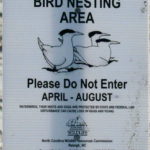
Bird Nesting Area
NC Wildlife Commission has posted signs that say – Bird Nesting Area / Please don’t disturb. The signs are posted on the west end beach strand around 1307 OBW.
People and dogs are supposed to stay out of the area from April through November
. 1) It’s a Plover nesting area
. 2) Allows migrating birds a place to land and rest without being disturbed
Upon Further Review –
 .
.
Key takeaways:
- Add 7’ asphalt to the south side of existing pavement
- Add 3’ asphalt to the north side of existing pavement
- Recenter the travel lanes
- Create two (2) five (5) foot bike lanes on either side of the road
DOT Bike Lane Report Presentation » click here

Paid parking in Holden Beach to start next month
As of May 1, paid parking will go into effect in designated areas at Holden Beach, located in Brunswick County 38 miles west of Wilmington. Commissioners passed the paid parking ordinance at the beginning of the month. It will be enacted April through October and affects 500 spaces, both for regular and low-speed vehicles. Beach goers will have to pay $3 per hour for up to four hours, $15 a day or $60 a week. Parking is enforced from 9 a.m. to 5 p.m. with license plate verification. Holden Beach utilizes the mobile app SurfCAST by Otto. Passes can be purchased by scanning QR codes on the signs, which go to the website https://surfcast.ottoconnect.us/pay. Parking can be paid via credit card, debit card or PayPal on the app.
Citations will be issued for:
• Parking without an active paid permit in a designated parking area
• Parking within 40 feet of a street intersection
• Parking in a crosswalk, sidewalk, or pedestrian access ways
• Parking blocking a driveway or mailbox
• Parking facing opposing traffic
• Parking in a no parking zone, or within right-of-way
• Parking on any portion of the roadway or travel lane
• Parking a non-LSV vehicle in an authorized LSV location
Annual passes are also available for purchase for $150 a year for a single vehicle or $250 a year for two vehicles. Handicap parking will remain free in designated spaces and must be proven by a valid license plate or hangtag.
For more information on parking, click here.
Read more » click here
Editor’s Note –
Rate has changed annual passes are $175 a year for a single vehicle
Paid parking at area beach towns to begin: Here are 2024 rates
Coastal communities from Pender to Brunswick counties will begin paid-parking programs starting March 1, with a few slated to kick off in April. Hourly costs, passes and timelines are listed below for beachgoers. To learn more — rules, fines for violations, residential free pass information, and how to access the applications to pay for parking — click the beach name in blue to go to the municipalities’ parking pages directly. Money from parking is intended to help fund the paid program as dictated by North Carolina Statute § 160A-301 which states revenue from public on-street metered parking must go toward parking maintenance; this doesn’t include town-owned lots. However, municipalities can petition legislators for an exemption to utilize proceeds otherwise. The GA has granted exceptions for Atlantic Beach, Beaufort, Carolina Beach, Kure Beach, Sunset Beach, Oak Island, Wrightsville Beach, Holden Beach and the City of Wilmington. Those monies fund needs benefitting public use, such as combatting beach erosion or paying for lifeguards.
Here is what visitors will pay this season:
Holden Beach
Located between Ocean Isle and Sunset Beach, Holden Beach contracts with Otto and its program runs April 1 through Oct. 31, 9 a.m. to 5 p.m.
Rates for the 2024 season are:
- Hourly: $4 up to four hours
- Daily: $20 for duration longer than four hours
- Weekly: $80 per seven consecutive days
- Annually: $150 for one vehicle
Oak Island
Oak Island first charged for parking in the 2023 season and continues to contract with Otto Connect this year. Marked spaces are paid April 1 through Sept. 30, 9 a.m. to 5 p.m.
Rates have not changed:
- Hourly: $5 up to three hours
- Daily: $20 per day or any duration greater than four hours
- Weekly: $80 per week for seven consecutive days
- Annually: $175, with a limit of 500 passes sold
Ocean Isle Beach
Currently, parking is free at beach accesses at Ocean Isle, including more than 200 spaces. Though overnight parking is not allowed in the town-owned spaces.
Parking is paid at the Ocean Isle Pier for $10 daily, $45 weekly and $175 seasonally. It’s free after 6 p.m.
There is also a privately owned lot that charges fees but is not operated by the town.
Though town leaders have discussed adding more paid parking to the beach town, nothing has passed yet.
Sunset Beach
Sunset Beach is one of the remaining beaches to offer parking for free in Brunswick County. However, parking at the pier is $10 per day with seasonal passes available through a lottery.
The coastal town has been gathering information about launching a paid parking program. It started a committee last year to help gauge next steps, which included conducting research and gathering input via surveys from area residents.
Read more » click here
Corrections & Amplifications –

Holden Beach Causeway – Facebook
Sometimes change is out of our control but if we recognize it in time, we can help influence change to have a positive outcome. Our community is special and no longer a secret. The area’s population increase is happening at a rapid pace. The Holden Beach Causeway has become insufficient to meet today’s demand. Spend a little time on the Causeway and it is easy to see it is unsafe for pedestrians and vehicles entering and exiting the local businesses. The crash rating on the Causeway is three (3) times higher than the NC state average for similar roads. Since 2018 I have persistently advocated for a study on developing the necessary changes needed on the Holden Beach Causeway. The Holden Beach Causeway Corridor Study was approved and funded in 2019. The study was developed with the influence of the Causeway property owners working with Brunswick County Planning, the North Carolina Department of Transportation and the Grand Strand Area Transportation Study (GSATS). A special thank you to the Causeway Property Owners who were a part of the Causeway Study Steering Committee. Lyn Holden, Gina Robinson, Steven Parish, Joe Shannon, Andrew Robinson and I dedicated a lot of time working on the study. Communicating with other Causeway property owners and representing what is right for our community, to prevent an unwanted outcome. The steering committee involved Tri-Beach Fire Department in the conversations. Including their opinions on the study’s development to assure they had sufficient access through the Causeway and to the island for emergency response. All headed up by the carefully chosen consulting firm, Bolten and Menk. The consulting firm did an amazing job working with all of the obstacles on the Causeway, consulting with the steering committee and business owners about their concerns of any negative impacts from the project. We are proud to present to you the Holden Beach Causeway Corridor Study. Please visit the link below to review the final draft. Considering all of the obstacles and considerations for everyone, the outcome offers a bright future for our community. It also provides a path for sustainability and safety for our Causeway and its businesses, as our area continues to grow.
What happens next?
Chairman to the Brunswick County Board of Commissioners, Commissioner Randy Thompson, has requested an endorsement for the Holden Beach Causeway Project from the Town of Holden Beach. Commissioner Thompson’s position for requesting the Town endorsement is the Causeway is the highway ingress, egress to the island. Next, the study will be presented to the Brunswick County Board of Commissioners for endorsement. Once the study has been endorsed by Brunswick County, the study will go back to the Grand Strand Area Transportation Study for adoption. Once adopted by GSATS, we can begin applying for Funding. It has been a long road to get to this point and we have a long road ahead to receive funding and begin construction. Thank you all for your support for the Holden Beach Causeway Project. We will need your continuous support as we navigate through the next phase of this process. I will keep this page posted as developments are made with the County required endorsements and the road to GSATS adoption.
Jabin Norris president of PROACTIVE Real Estate
For more information » click here
HB Causeway Study Report » click here
THB Newsletter (01/25/24)
Holden Beach Causeway Study
The Grand Strand Area Transportation Study MPO (GSATS) funded a study to improve the Holden Beach Causeway by observing the area and addressing the concerns of Causeway business owners and patrons as well as the community related to vehicular and pedestrian safety, accessibility, right‐of‐way encroachments, and parking deficiencies. This study provides insight as to how the corridor functions and ideas for future improvements from a transportation and land use perspective.
For more information and to view the study, visit the Brunswick County Planning Department’s website: https://www.brunswickcountync.gov/409/Holden-Beach-Causeway-Transportation-Cor
The Draft Holden Beach Causeway Transportation Study will go to the Brunswick County Board of Commissioners for a public hearing and for their consideration on February 5, 2024, at 3:00 p.m.
THB Newsletter (02/01/24)
Holden Beach Causeway Study
The date the Draft Holden Beach Causeway Transportation Study will go to the Brunswick County Board of Commissioners for a public hearing and for their consideration has been changed to March 18th at 6:00 p.m.
For more information and to view the study, visit the Brunswick County Planning Department’s website: https://www.brunswickcountync.gov/409/Holden-Beach-Causeway-Transportation-Cor.
Holden Beach Causeway study approved for future planning
The Grand Strand Area Transportation Study (GSATS) transportation advisory committee (TAC) on Friday, Feb. 16, voted to add the Holden Beach Causeway Corridor Study into GSATS’ long-range planning. The action did not approve the implementation of any projects but the entire study will be in the GSATS Metropolitan Transportation Plan (MTP), making it eligible for federal funding if project recommendations are ever put to action. “It will never be a project unless the county comes forward and wants it to be a project,” GSATS Metropolitan Planning Organization (MPO) Director Mark Hoeweler said. Hoeweler said the Technical Coordinating Committee (TCC) recommended the TAC approve the study and add it to the GSATS MTP as an appendix. “We update that document every five years,” he added. “It has a 20-year horizon to it.” The Holden Beach Road Causeway stretches from the Sabbath Home Road-Holden Beach Road intersection to near the base of the Holden Beach Bridge. The causeway is owned by the North Carolina Department of Transportation (NCDOT) and is not within the Town of Holden Beach town limits. The GSATS 2040 MTP already contains plans to widen NC 130 from the intersection of Sabbath Home Road and Holden Beach Road to the end of state maintenance, near the bridge, and add a multipurpose path. Designer Grant Meacci with Bolton & Menk, Inc., who created the study, said the study addresses parking, pedestrian safety and accessibility, and encourages supporting existing businesses. Meacci’s presentation detailed adjacent property zoning, land uses and environmental conservation areas in the study area, noting the study incorporated the county’s Blueprint Brunswick 2040 Comprehensive Land Use Plan and Parks and Recreation Master Plan, along with other demographic and traffic data related to the Holden Beach causeway area too. “So, we take all those types of analysis and start to look at what is likely to change in the area — in the immediate area — in terms of development,” he explained. The study shows there’s not a lot of “room for change other than redevelopment over time,” Meacci noted, and that developmental factors are not expected to cause a large traffic increase on the causeway. The designer said most local roads are for residential use and that the vehicle traffic on the Holden Beach causeway fluctuates between 7,000 and 10,000 trips per day throughout the year. Regarding car crashes, he said nearly half of all the crashes along the causeway are related to drivers taking left turns. A steering committee was formed to identify assets and opportunities that are specific to the causeway. Representatives of the NCDOT, GSATS, corridor business owners and property owners, and the Brunswick County Planning Department were on the committee. Meacci said the committee had meetings, public workshops and community open houses. A community survey was also sent out, which garnered 1,490 responses. A majority of participants were residents, business owners and property owners, Meacci added. Most survey respondents were folks who reside in Holden Beach, Supply, Varnamtown, Shallotte and unincorporated Brunswick County. A large portion of survey respondents said they do not feel safe traveling the causeway as cyclists and pedestrians. Meacci said the causeway’s right-of-way width is not consistent, stating there are three different widths along the causeway as it becomes wider closer to the Holden Beach bridge. The study highlights how different road design options could impact local businesses, pedestrians, drivers, and beautification, he noted. The study proposed three different design options for the causeway, Meacci said, but eventually the options evolved into two alternate designs with one recommendation. In all options, a wide multi-use path with parallel parking and street trees on both causeway sides is included. The study’s parking analysis counted a total of 795 marked and unmarked parking spaces along the causeway. Of the 795 parking spaces, 449 are on private property and 252 are in the public right of way. Options for no on-street parking, diagonal on-street parking and parallel on-street parking were given in the presentation, however, Meacci said diagonal on-street parking would allow for more parking spaces. The two alternative designs included a design that had a mix of parallel parking and diagonal parking along the causeway and a different design with no parking, with the preferred recommended alternative design being the mixed parking option. Meacci noted mixed parking installation would increase parking along the right of way from 252 to 324 spaces and increase private property parking from 449 to 584 spaces. The recommendation also includes parking for oversized vehicles. “There was a recommendation to reduce the speed limit from 45 [miles per hour] to 30 [miles per hour],” Meacci said. He said the development of an Overlay District to direct future redevelopment and improvements has also been recommended. The district would ensure buildings are “appropriately placed” along the corridor and promote land use standards and mixed use areas. The study recommendation encourages people to park once and walk from business to business, Meacci said. It includes adding crosswalks, street lights and other beautification elements along the causeway, too. Hoeweler explained that the TAC’s approval of the study sets the plan up for future implementation and makes the study eligible for federal and grant funding. “So, therefore, if anybody in the future wants to do one of those intersection projects and wants to add something, we’ve got a template to work off of,” he said, noting approval of the study is not approval of the projects within the study. If all the projects within the study come to fruition, the entire project cost estimate is $8,143,000. The cost includes ADA-compliant concrete curb ramps for paths at driveways and crossroads, crosswalks with accessible pedestrian signal push buttons at the traffic signal at Sabbath Home Road and Holden Beach Road and 60 benches. Hoeweler said GSATS could help fund parts of the project, like a bike path or sidewalks, but not the entire project. Asked if the town of Holden Beach had been included in development of the study, Holden Beach Mayor Alan Holden and Town Manager David Hewett both said the town was not invited to participate. Mayor Holden told The Brunswick Beacon he owns property along the corridor and had no comment on the study. A draft of the study and cost estimates can be found on Brunswick County’s website at https://www.brunswickcountync.gov/409/Holden-Beach-Causeway-Transportation-Cor.
Read more » click here
Odds & Ends –

HB Turtle Patrol 2024 shirts now available
Members of the Holden Beach Turtle Watch Program (also called the Turtle Patrol) have announced that their 2024 shirt is now available for sale. There’s a new shirt each year and this one celebrates 35 years of sea turtle conservation on Holden Beach. In 1989, Judy Bryan and a small group of volunteers started the Holden Beach Turtle Patrol. Since then, dedicated volunteers on Holden Beach have given hundreds of thousands of hours to help ensure sea turtle survival. Committed to protecting sea turtles, patrol volunteers secure nest sites, educate the public and quietly celebrate as more than 4,800 hatchlings begin their journey each year on Holden Beach. The 2024 shirt highlights this 35-year commitment to the sea turtle population featuring hatchlings (be sure to count them!) as they make their way to the ocean on a moonlit night on Holden Beach. Shirts can be purchased at The Lighthouse Gifts on the Holden Beach causeway. Shirts are also available by mail from the HBTWP website (hbturtlewatch.org). The sale of shirts is the Turtle Patrol’s major fund-raising activity each year. Tote bags and hats are also available this year! If you’re interested in becoming a HBTP volunteer, now is the time to apply. Send a message to Pat Cusack, program coordinator, from the HBTWP website’s Contact page, or email him directly at [email protected] for an application or to learn more about qualifications and requirements. Typically, a new volunteer will be a “trainee” for an entire summer. Being a trainee involves working on the beach both morning and evenings, shadowing current members and attending educational programs. The annual meeting for the Holden Beach Turtle Watch Program, Inc. will be Saturday, April 6, at 10 a.m. at the Holden Beach Chapel. The HBTWP was founded to monitor and protect the sea turtle population on Holden Beach. This all volunteer, nonprofit conservation organization operates under the authority of the NC Wildlife Resources Commission (ES Permit 24ST11).
For more information on the HBTWP, visit their website at https://hbturtlewatch.org/ or visit them on Facebook.
Read more » click here
 DNA study reveals statistics about Holden Beach 2023 sea turtle nesting season
DNA study reveals statistics about Holden Beach 2023 sea turtle nesting season
A DNA study of sea turtle nests in Holden Beach was recently completed, revealing interesting statistics about the 2023 season. According to a Holden Beach sea turtle program, 65 of 70 loggerhead nests were analyzed, indicating 29 unique females laid nests on their beach last year — an average of 2.4 nests per female. One turtle laid five nests within 1.3 miles of shoreline. The turtle with the most nests laid six. Volunteers say that specific turtle has been laying nests on Holden Beach since 2014.
Read more » click here

Brunswick County reminds residents to practice severe weather safety
March 3-9 is Severe Weather Preparedness Week in North Carolina. Brunswick County Emergency Management urges residents and community members to be ready for severe weather events and to understand the risks that can come with them. “Spring brings the potential for severe weather,” said Brunswick County Emergency Management Director David McIntire. “With warmer weather quickly approaching, now is the time for you and your loved ones to start preparing for the severe weather season. Sign up for ReadyBrunswick to make sure we can contact you during an emergency.” Severe weather can happen anywhere and at any time. Not only can severe thunderstorms develop rapidly, but they can also bring lightning, hail, flash floods, and tornadoes. Brunswick County officials encourage community members to take this week to create a household emergency plan and update emergency supply kits. Brunswick County also encourages community members to practice their emergency plan by participating in the annual statewide tornado drill on Wednesday, March 6, 2024, at 9:30 a.m. The National Weather Service (NWS) will broadcast the drill over the Emergency Alert System (EAS) on radio and TV and on National Oceanic and Atmospheric Administration (NOAA) weather radios. “We encourage all county residents, visitors, businesses, and organizations to participate in the upcoming tornado drill,” McIntire said. “Creating a plan is only one part of being prepared. Practicing your plan will help you and your loved ones know where to go and what to do when severe weather strikes.” Tornadoes form during severe thunderstorms when winds change direction and increase in speed. These storms can produce large hail and damaging winds that can reach 300 miles per hour. In 2023, the NWS recorded 24 tornado touchdowns across North Carolina, and 127 large hail events (hail that is 1 inch in diameter or larger), 844 damaging thunderstorm wind events, and 139 flood or flash flood events.
Emergency officials recommend the following safety tips:
Before Severe Weather
- Know the terms. WATCH means severe weather is possible. WARNING means severe weather is occurring; take shelter immediately.
- Make a plan. Develop a household emergency plan so all members know where to go, who to call, and what to do during a disaster.
- Prepare a kit. Assemble an emergency supply kit for use at home or in your vehicle. Make sure to include a 3-day supply of non-perishable food and bottled water for each household member and pets. The Brunswick County Center of the N.C. Cooperative Extension has prepared a hurricane cookbook to help individuals and families prepare meals in advance in case of an emergency.
- Subscribe to emergency alerts. Residents and visitors can sign up for alerts from ReadyBrunswick, Brunswick County’s emergency notification system.
- Sign up for the Special Needs Registry. Residents are strongly encouraged to sign up for the Brunswick County Special Needs Registry if they have additional needs in functional areas. These functional needs may include but are not limited to maintaining independence, communication, transportation, supervision, and medical care.
During Severe Weather
- Stay informed. During an emergency, stay tuned to reliable local media outlets, listen to NWS weather alerts, and follow Brunswick County on social media for continuous updates. You can also subscribe to receive email updates from the County to stay updated on media releases and important announcements.
- Find a safe room. Know where the nearest safe room is, such as a basement or interior room and away from windows. Go there immediately if you hear or see a tornado.
- Seek shelter. If driving, you should leave your vehicle immediately to seek safety in an adequately safe structure. Do not try to outrun a tornado in your vehicle, and do not stop under an overpass or a bridge. If there is no shelter available, take cover in a low-lying flat area. Watch out for flying debris.
Read more » click here

Alerts
Brunswick County uses ReadyBrunswick as part of the County’s effort to continuously improve communications during emergency situations within our area. Powered by Everbridge, the ReadyBrunswick notification system sends emergency notifications in a variety of communication methods such as:
- Landline (Voice)
- VoIP (Voice over Internet Protocol)
- Mobile (Voice)
- Mobile SMS (Text Messaging)
In the case of an emergency, you may choose to receive notifications via one or all of these communication methods. It’s recommended that you register several media options to receive messages in the event a particular communication device is unavailable.
For more information » click here
Brunswick County Emergency Communications Notification System
Get notified about emergencies and other important community news by signing up for our ReadyBrunswick Emergency Notification System. This system enables us to provide you with critical information quickly in a variety of situations, such as severe weather, unexpected road closures, missing persons, evacuations of buildings or neighborhoods, and more. You will receive time-sensitive messages wherever you specify, such as your home, mobile or business phones, email address, text messages and more. You pick where, you pick how.
SIGN UP HERE to choose the type of alerts you want to receive.
This and That –
Another boat access could enter the water near Holden Beach
During the North Carolina Wildlife Resources Commission’s (NCWRC) Committee of the Whole meeting on Feb. 21, the committee discussed creating another boating access area near Holden Beach to connect to the Intracoastal Waterway. Local fishermen, captains and residents have been fighting for more boat and trailer parking space in Holden Beach for over a year, and this potential project could bring that to the area, along with a potential third boat ramp. The commission unanimously voted in favor of moving the project to “phase I.” Ben Solomon, assistant chief and land acquisition manager of the commission’s Land and Water Access Division, presented a slideshow on the land purchase opportunities and the roughly drafted project. He said the boat access sketch plan and parking plan are only conceptual. “Most boat ramps in Brunswick County, aside from Holden Beach, operate at over-capacity status at this time,” Solomon said. Brunswick County only has six public boat ramps with 233 trailer parking spaces, he explained, and it would be important to keep the existing ramp on Holden Beach. He said the existing Holden Beach boat access is a small ramp with limited parking for the high volume of boat traffic that residents and visitors bring. “Just within Brunswick County, we have 12,000 registered vessels,” he said. “There’s an additional 18,000 registered vessels in surrounding counties.” Solomon showed the commission three separate parcels they are looking to purchase off Cedar Landing Road SW — adjacent to the Holden Beach Marina and Holden Beach Bridge — noting a developer also wants to purchase them. If purchased, the access would be located in county jurisdiction. There are two options the commission considered: Option A and Option B. Option A calls for purchasing all three parcels that total 3.7 acres and Option B calls for purchasing only two parcels that total 1.9 acres. The asking price for Option A is $5.9 million and the asking price for the Option B parcels is $3.2 million. The NCWRC received phase I approval to pursue the acquisition of the three parcels for Option A, Solomon told The Brunswick Beacon on Monday, March 11. “Phase I approval is the first step in the Commission’s land acquisition process and allows commission staff to work with the State Property Office to order an appraisal for the subject properties and further develop the project,” he explained. He told the commission that the access site will have maximum level parking if they pursue all three parcels. Option A would bring 98 trailer parking spaces and 17 car parking spaces to the area if the project comes to fruition. Option B would only bring approximately 53 trailer parking spaces and six car parking spaces. Solomon said the trailer parking spaces would fit both the vehicle and the trailer. Tax parcel 232NA001, the middle parcel, houses a commercial building with an existing boat launch. Solomon said the commission would try to permit a second boat launch to be put in the access area. The conceptual design is still subject to permitting and approvals that could restrict plans, Solomon added. “This is a good baseline for us to look at and get a feel for,” he said. The project could cost between $1.5 and $1.9 million, he said, but that cost would include site-level parking, two boat ramps and structure removal from one of the parcels. Solomon said potential funding sources for the project are the coastal recreational fishing license grant, state funds and possible legislative appropriation. “The Commission does have an interest in expanding public boating access opportunities around Holden Beach and plans to further assess feasibility of this potential boating access area by ordering an appraisal and developing funding partnerships,” he told The Brunswick Beacon. To access the recording of the February Committee of the Whole meeting, go to https://www.youtube.com/watch?v=TQPj77J1jZE.
Read more » click here
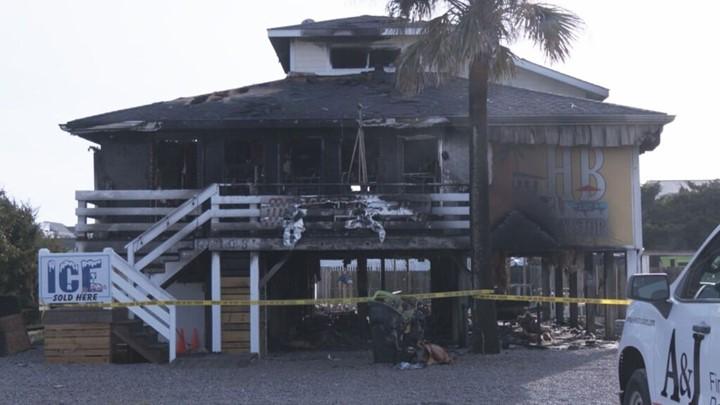
Holden Beach business destroyed in overnight fire
A convenience store and bar in Holden Beach is in ruins after a two-alarm fire Thursday night. Videos and pictures from WECT viewers show flames shooting out of the roof of the Holden Beach Trolley Stop on Jordan Boulevard. Chief Doug Todd with the Tri-Beach Volunteer Fire Department says the initial call for the fire came in around 11:11 p.m. Firefighters arrived at the scene within minutes and put out the flames, then stayed on scene until just after 4:00 a.m. to extinguish and monitor hot spots. Todd says the fire appears to have started in the business’s bar area on the ground floor. He says investigators believe it was an accident, but they are still searching for an exact cause. No one was hurt. Several agencies helped with the initial fire response, including Supply VFD, Civietown Fire/Rescue, Shallotte Fire Department, Brunswick County EMS, and Holden Beach Police. Crews with the Ocean Isle Beach Fire Department and Sunset Harbor & Zion Hill VFD responded on the second alarm. The Brunswick County Fire Marshall’s office was also at the scene and is investigating.
Read more » click here
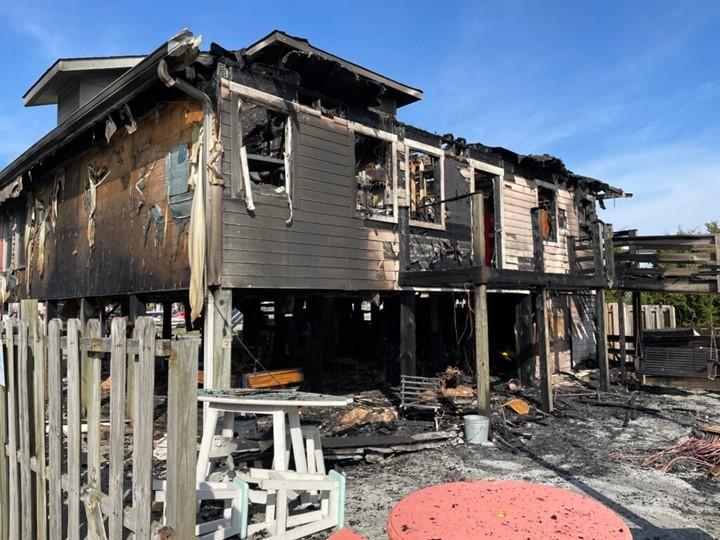 Holden Breach Trolley Shop owners prepare to rebuild following fire that destroyed 30 plus year old shop
Holden Breach Trolley Shop owners prepare to rebuild following fire that destroyed 30 plus year old shop
The owners of a long-running business in Holden Beach are surveying the damage following a fire late Thursday night. Crews responded to the Trolley Stop convenience store and bar on Jordan Boulevard around 11 Thursday night. The owners said they were preparing for the beach season by staining tables for the shop’s bar and outdoor area. Security camera footage shows the moment a bag of stain-soaked rags appears to catch fire spontaneously. Jeremy and Cynthia Ridenhour purchased the shop back in 2019 and said they were excited for the new season. They said it’s difficult seeing something they’ve put so much work into going up in flames. “We’ve had people follow us throughout the whole time that we’ve had it and just to watch all fall and to go away has just been devastating for us,” Cynthia said. “It’s a tragic loss, it’s a tragic loss for the community. It’s a tragic loss for everybody that’s worked so hard and out so much into it. You know, our customers, our family, our friends,” Jeremy said. Jessica Almond is a friend and frequent customer at the shop. She said that it held a special place in Holden Beach. “Literally I’ve met friends, I moved from the Charlotte area, and I’ve met friends that have become family to me,” Almond said. “The owners, the Ridenhours, they became family to me and the whole community. It’s just a place to let loose and have a good time and everyone becomes family here.” The Ridenhours said they will eventually rebuild and they’re glad no one was hurt. They also said its important to properly dispose of rags or cloth with stain on it, so you don’t find yourself in a similar situation.
Read more » click here

Gov. Cooper and Sen. Rabon want to use native plants in state landscaping projects. Why?
Legislation and executive orders now require state agencies to first see about using NC-native plants and trees in state landscaping projects. But why aren’t we doing that already?
The number hovers around 14 percent. That’s how many plants sold in North Carolina are considered native. Horticulturists, researchers, state Sen. Bill Rabon, R-Brunswick, and now Gov. Roy Cooper believe that number is much too low and is costing the state’s flora and fauna in the process. But officials say increasing the number of shrubs, plants and trees endemic to North Carolina in yards, along roads, in parks, and in backyards isn’t as easy as simply saying it’s the right thing to do − even if most people already know Bradford pears are stinky, fragile, invasive trees that should be avoided. Here’s a look at some of the challenges to increasing the use of native plants in North Carolina, and steps already underway to convince landscapers and backyard gardeners to plant Virginia creeper, for example, instead of English ivy.
The power of the pen
Last month, Cooper signed Executive Order 305. While the order focused mostly on aspirational goals to preserve millions of acres of North Carolina forest and wetlands by 2040, it also included language ordering state agencies to whenever possible use native plants for landscaping projects on state-owned property. Native North Carolina plants generally are defined as those that occurred in the state before European settlement. Non-native, or exotic, plants are those that are not native to the Tar Heel State. “State-funded or permitted projects and activities, including those administered on behalf of the federal government, shall avoid introducing non-native plants,” the order states. “To support native biodiversity, cabinet agencies shall also consider the native plant practices of private properties in future lease agreements.” Since the state is North Carolina’s largest landowner, with universities, state parks, historic sites, and right of ways along roads maintained by the N.C. Department of Transportation covered by the order, the move could mean a dramatic increase in the number of native plants appearing across the state. The governor’s order piggybacks on legislation that’s been championed by Sen. Bill Rabon for years. His Native Plants Act, which became law last year, requires plants native to the Southeastern U.S., “with a strong preference for plants native to North Carolina,” to be used in landscaping projects in state parks and along state highways.
Shouldn’t we be going native all the time already?
While a question and would seem to have a simple answer, it isn’t, well, that simple. Chris Moorman, a wildlife ecologist at N.C. State University, said landscapers often have to pick plants to meet a certain objective, say providing shade for a parking lot. While going native naturally provides some of the best food and groundcover requirements for local wildlife, it might not meet the goal of the project, and thus a non-native plant is a better fit for that particular role. “Native plants aren’t always necessarily the only answer,” said Dr. Barbara Fair, a landscape extension specialist at N.C. State. She said that in our urban areas where the landscape has been changed dramatically by humans, sometimes non-natives are just a better fit − especially when it comes to meeting certain functions and promoting biodiversity. “They can just often survive and thrive better in these very altered environments,” Fair said, ticking off the benefits from mitigating heat to handling stormwater runoff that urban trees offer.
What are the advantages of going NC-plants first?
The advantages for native wildlife and insects is easy to see. “From an ecological standpoint, they have co-evolved with the local communities, including the plants and animals,” Moorman said. “Because native wildlife co-evolved with native plants, there are often critical linkages between the individual plants and animal natural history.”
Native plants also reflect North Carolina’s rich ecological history and are often tied into many of the state’s cultural traditions and foods. But there are other, more pragmatic reasons to go native, too. Native vegetation is designed to better handle North Carolina’s often hard growing conditions, which climate change is forecast to exasperate − not to mention stronger and bigger hurricanes. With natives often more drought- and heat-tolerant than non-native plants, and with longer periods of dry, hot weather forecast for North Carolina in coming decades, officials say they are often a hardier bet than exotics from another part of the country or world. Native coastal plants are also generally better able to withstand salt water, which can make them a better alternative for waterfront homeowners with sea levels projected to keep rising in coming decades and tide surges set to increase. Then there is the popularity of the Tar Heel State. North Carolina’s population in 2000 was just over 8 million. It is estimated to be nearly 10.9 million by April, according to the latest U.S. Census figure. Projections estimate the state will be home to nearly 14 million people by 2050. “Urban development removes much of the preexisting vegetation cover, so landscaping with native plants can return that lost vegetation cover, along with the food and cover the plants provide for wildlife,” Moorman said. “Animals are critical dispersal agents, especially birds, so fostering the linkage between native plants and wildlife helps foster native plant persistence.”
Is going native easy?
Not as easy as it should be, but that hopefully will change in the coming years, officials said. “People plant what they see in big box stores and what they see planted around them, which largely is not native plants,” Moorman said. They also often look for what they used to have in their gardens before moving to North Carolina. But what worked in Connecticut or Ohio might not be the best choice in hot, sandy and often nutrient-poor soils of North Carolina’s Coastal Plain. There’s also a financial risk for landscapers, homeowners and even nurseries to increase their stock of native plants if people either aren’t going to buy them because they don’t know what they are or they die quickly when planted due to being placed in the wrong conditions. “That’s the million-dollar question, really, and it’s a very complicated answer,” Fair said of increasing the stock of native plants. She said many native trees aren’t fast growers − one of the reason crepe myrtles are so prevalent in urban areas − and people’s tastes can be finicky. Then there are issues for the plant industry, like how quickly can they ramp up production of native flora and is it a wise investment. “Yes, it’s certainly something we should work to promote,” Fair said, noting the educational outreach efforts many state agencies and local nurseries do to promote native plants. “But we have to realize this is a long-term process that we need to be thinking about.”
Want to go native? Here are some resources:
- C. Botanical Gardens: Lots of native plant resources for gardeners
- C. Native Plant Society: The name says it all!
- Coastal Landscapes Initiative: A collaborative effort among agencies that includes plenty of native plant guides and videos.
- C. Sea Grant magazine: Article that highlights 12 native plants that thrive in the harsh conditions found along the N.C. coast.
- Tips for going native in New Hanover County: Local cooperative extension office offers useful pointers.
- Landscaping for wildlife with native plants: Useful tips from the N.C. Cooperative Extension.
- Going native for the birds: Making your urban or suburban garden an oasis for local birds.
- Want to attract butterflies? Add some flying colors to your backyard by going native.
Read more » click here
NC State Native Plant Resources » click here
NC Sea Grant Coastal Landscapes » click here
New Hanover County Arboretum Native Plant Garden » click here
Audubon Native Plant Database » click here
Fauna & Flora » click here
Holden Beach recommended plant list – deer resistant & salt tolerant
Factoid That May Interest Only Me –

Switching the Clocks Twice a Year Isn’t Just Annoying. It’s Deadly.
An hour of the day will be unceremoniously snatched away on Sunday as we “spring forward” to daylight saving time. Polling shows that more than half of Americans want to “ditch the switch” and prefer daylight saving over standard time by a margin of 10 to 20 points. But making that switch permanent would require an act of Congress, and while the Senate managed to pass a bill called the Sunshine Protection Act two years ago, the legislation never made it through the House. Worryingly, state legislators from Maine to the West Coast are now so fed up with waiting that they have introduced their own bills to remain on standard time permanently; states can do that without Congress. But such a switch would be a mistake. It’s not just that our afternoons and evenings would be shrouded in more darkness, which often comes with higher crime, more vehicle collisions and fewer opportunities to enjoy the outdoors after work or school. There’s another problem with standard time, and it’s gone all but unnoticed until now. Last year, my research team showed that standard time leads to far more vehicles colliding with deer. Vehicle strikes already kill millions of wild animals each year, and collisions with deer are the best documented because they are so common and damaging. When we looked at over one million collisions between deer and vehicles in 23 states across the United States between 1994 and 2021, we found these collisions are 14 times as likely in the two hours after sunset, compared to the two hours before. Deer behavior does not quite explain this since they are equally active at dawn and dusk. But traffic volumes are higher in the evening, and it’s hard for us to see things in the dark. The hour-earlier sunset that comes with standard time is thus an expensive, traumatic way to control the deer population. In all, we found that staying on daylight saving time year-round would prevent an estimated 36,550 collisions between deer and vehicles, whereas staying on standard time would add 73,660 of these collisions every year — a difference of more than 100,000. The human toll of staying on standard time would also be significant: Compared to year-round daylight saving time, year-round standard time would cause 100 more deaths, 6,000 more injuries and at least $3.5 billion in costs every year through increased deer-vehicle collisions alone. Of course, more crashes with deer is far from the only cost of standard time. The number of fatal traffic accidents at night — caused by deer or anything else — is three times higher than it is during the day, and the dark increases the risk of pedestrian accidents by up to seven times. Permanent daylight saving time would prevent 366 fatal pedestrian and vehicle accidents a year with the help of brighter evenings during the 4.5 months of the year we currently spend on standard time. Conversely, staying on standard time for an extra 7.5 months each year would add about 610 fatalities — a difference of nearly 1,000 human lives. Support for standard time has been growing in recent years, driven in large part by sleep scientists who argue it’s better aligned with humans’ circadian rhythm. One clever study compared sleep patterns of people living on either side of time zone boundaries as proxies for having sunrise come an hour earlier versus later. Those living in the proxy standard time regime got an average of 19 minutes more sleep per day, and the same study valued the associated health benefits at more than $2 billion. This is an impressive benefit, but not enough to outweigh the $3.5 billion this country would be paying to fix the damage incurred by deer collisions should we implement permanent standard time. The trump card of standard time proponents is that we tried permanent daylight saving time once before — in 1974. After it went into effect, only 42 percent of Americans favored the change. Some parents disliked sending their children to school in the dark, and in only a few weeks, eight school children were hit by vehicles and killed in Florida alone, convincing lawmakers to reverse the shift. Eight deaths may sound like a lot, but if you look at the country as a whole, morning fatalities of school children barely rose that January, from 19 to 20 — a shift that could be explained by normal year-to-year fluctuations. And if we were again to try making daylight saving time permanent, we’d save many more lives in the evenings. I can understand why parents are worried about sending their children to school in the dark. But the best solution to that problem would be to have school start later. (Already many medical associations support this because of the variety of health benefits it could offer children, including the fact that they would get more sleep.) If we move to permanent daylight saving time, we would potentially prevent hundreds of traffic deaths and tens of thousands of collisions between deer and vehicles. Robberies could drop by 7 percent. Congress has the power to make this a reality. The Sunshine Protection Act was reintroduced to the House and Senate last March with broad bipartisan support — only to languish in the House Energy and Commerce Committee and the Senate Commerce, Science and Transportation Committee for a year. It’s up to the leaders of these committees to prioritize the issue this spring. Every year, we gripe about the time switch, demand action and then return to our daily lives. But the toll on people and wildlife is too large to keep doing this year after year. And the longer Congress waits, the greater the risk of state bills for permanent standard time passing, making things worse instead of better. It’s time to spring forward permanently and enjoy the benefits of brighter evenings year-round.
Read more » click here

Island Homes Sold – 2023 * Lou’s Views (lousviews.com)
A complete list of homes sold in 2023
Island Land Sold – 2023 * Lou’s Views (lousviews.com)
A complete list of land sold in 2023
Island Properties Sold – Comparison * Lou’s Views (lousviews.com)
A comparison of Holden Beach properties sold through the last three (3) years
County real estate market closes out 2023 with strong, consistent numbers
Brunswick County’s residential real estate market closed out 2023 with numbers very similar to last year’s performance. The number of new listings increased, while the average sales price, the number of homes sold, and total sales volume all saw slight decreases compared to 2022. “2023’s numbers were very similar to 2022, and our market seems to be cruising along steady and smooth,” said Cynthia Walsh BCAR CEO. “Thanks to continued strong demand, average sales prices increased throughout the year; however, total sales volume is slightly down compared to last year, but it’s hard to complain about $2 billion in sales. Overall, our market is positioned for a strong 2024.” Total sales volume decreased from $2,530,790,000 in 2022 to $2,486,990,000 in 2023. Average sales prices for the year were down 2.8% compared to 2022, from $453,440 to $440,865. New listings increased 5.6%, from 6,068 to 6,407, and the number of units sold dropped 5%, from 5,572 to 5,295. When it comes to December’s numbers, they tracked as expected with fewer homes sold, and a slight increase in new listings and average sales prices. Total sales volume decreased 5.9% compared to December 2022, from $180,100,000 to $169,400,000, while average sales prices were up 4.1%, from $445,799 to $464,117. Luxury homes may have been the holiday gift of the season, with 22 transactions in excess of $1 million, four in excess of $2 million and one in excess of $3 million. New listings were up 6.2% in December, from 325 to 345, and the number of units sold dropped 9.7%, from 404 to 365. Homes spent an average of 50 days on the market in December. The absorption rate, which is the amount of time it would take to sell all available inventory, remains around three months.
Brunswick County
New Listings
December 2023: 345
December 2022: 325
Increase/Decrease: +6.2%
Units Sold
December 2023: 365
December 2022: 404
Increase/Decrease: -9.7%
Average Sales Price
December 2023: $464,117
December 2022: $445,799
Increase/Decrease: +4.1%
Median Sales Price
December 2023: $353,500
December 2022: $359,900
Increase/Decrease: -1.8%
Total Sales Volume
December 2023: $169,400,000
December 2022: $180,100,000
Increase/Decrease: -5.9%
The Brunswick County Association of Realtors (BCAR) is the local association level of the largest trade association in the nation, presently serving its members, which are comprised of realtors, appraisers and affiliate members. Chartered in 1959 by the National Association of Realtors (NAR), BCAR represents the interests of its members in southeastern North Carolina and northeastern South Carolina. For more information, visit https://bcarnc.com/.
Read more » click here
Hot Button Issues –
Subjects that are important to people and about which they have strong opinions

Climate
For more information » click here
.
There’s something happening here
What it is ain’t exactly clear
Weirdly Warm Winter Has Climate Fingerprints All Over It, Study Says
Recent heat waves in cities worldwide have the hallmarks of global warming, researchers said. And last month was the hottest February on record.
Winter was weirdly warm for half the world’s population, driven in many places by the burning of fossil fuels, according to an analysis of temperature data from hundreds of locations worldwide. That aligns with the findings published late Wednesday by the European Union’s climate monitoring organization, Copernicus: The world as a whole experienced the hottest February on record, making it the ninth consecutive month of record temperatures. Even more startling, global ocean temperatures in February were at an all-time high for any time of year, according to Copernicus. Taken together, the two sets of figures offer a portrait of an unequivocally warming world that, combined with a natural El Niño weather pattern this year, has made winter unrecognizable in some places. The first analysis, conducted by Climate Central, an independent research group based in New Jersey, found that in several cities in North America, Europe and Asia, not only was winter unusually warm, but climate change played a distinctly recognizable role. Climate Central looked at anomalies in December and January temperature data in 678 cities worldwide and asked: How important are the fingerprints of climate change for these unusual temperatures? That is to say, its researchers tried to isolate the usual variability of the weather from the influence of climate change. “There’s the temperature,” said Andrew Pershing, Climate Central’s vice-president for science, “and then there’s our ability to really detect that climate signal in the data.” Cities in the Midwestern United States jumped out for experiencing an extraordinarily warm winter and for the influence of climate change, which is caused mainly by the burning of coal, oil and other fossil fuels that release greenhouse gases into the atmosphere. “Really off the charts,” Dr. Pershing said. “No ice on most of the great lakes. That’s remarkable.” Minneapolis, for instance, was nearly 5.6 degrees Celsius warmer than average between December and February. The fingerprints of climate change could be detected for 33 days, essentially a third of the winter season. Tehran was 4.2 degrees Celsius warmer on average during the same three-month period. The effects of human-made climate change could be detected over 68 days of winter. Milan’s winter average temperature was roughly 2 degrees Celsius higher, but there was a strong climate change signal over 55 days. Elsewhere, even though there were a few significantly hot days, winter average temperatures didn’t vary wildly, and the climate signal was less pronounced. The Climate Central report, also published Wednesday, concluded that 4.8 billion people worldwide “experienced at least one day of temperatures that would be virtually impossible without the influence of carbon pollution.” In some parts of the world, the unusually warm winter weather was overshadowed by other crises, such as war. Several cities in Ukraine were significantly warmer than usual, and there, too, were the fingerprints of climate change. Kyiv, for instance, was nearly 3 degrees Celsius warmer on average this winter, and climate change was seen to have played a role for 33 days. Likewise, in several cities of Iran, Iraq and Afghanistan. In the tropical belt, where it’s usually much hotter on average, climate signals are easier to detect, though temperature increases can be smaller. Jakarta and Kuala Lumpur for instance were barely 1 degree Celsius warmer on average. But the effects of climate change could be detected for nearly the entire three-month period. It’s not just individual cities that set records this winter. Globally, February 2024 was the warmest February on record, according to the Copernicus Climate Change Service. It was 1.77 degrees Celsius above the average February temperature in the recent preindustrial era from 1850-1900. This is the ninth month in a row to break the temperature record for that respective month. Taken together, the past 12 months have been the hottest 12 consecutive months on record: 1.56 degrees Celsius above the average from 1850-1900. “A year ago, the fact that the global temperature for a particular month would reach 1.5 degrees C above the pre-industrial level would have been considered exceptional,” said Julien Nicolas, a senior scientist at Copernicus, via email. Now, it’s happened repeatedly. This doesn’t mean we have exceeded the international Paris Agreement goal of stopping global warming at 1.5 degrees Celsius above the preindustrial temperature. For that to happen, the planet would need to be 1.5 degrees warmer for several years, long enough to reflect a more permanent change. For now, in the short term, the ocean has been particularly hot. The average global sea-surface temperature in February was the warmest recorded for any month, surpassing the previous record set in August 2023.
Read more » click here
The planet just shattered heat records for the ninth month in a row
Last month was the planet’s hottest February on record, marking the ninth month in a row that global records tumbled, according to new data from Copernicus, the European Union’s climate monitoring service. February was 1.77 degrees Celsius warmer than the average February in pre-industrial times, Copernicus found, and it capped off the hottest 12-month period in recorded history, at 1.56 degrees above pre-industrial levels. It’s yet another grim climate change milestone, as the long-term impacts of human-caused global warming are given a boost by El Niño, a natural climate fluctuation. “February joins the long streak of records of the last few months. As remarkable as this might appear, it is not really surprising as the continuous warming of the climate system inevitably leads to new temperature extremes,” Carlo Buontempo, director of Copernicus, said in a statement. Even in the context of back-to-back months of unprecedented temperatures, February has been extreme. Global temperatures in the first half of the month in particular were “exceptionally high,” according to the analysis. Four consecutive days, from February 8 to 11, were 2 degrees warmer than those same days pre-industrial times. Restricting global heating to well below 2 degrees was a centerpiece of the Paris Agreement that almost every country signed up to in 2015. While scientists are much more concerned with longer-term warming, these temporary breaches are a clear and alarming sign of accelerating heating. Global ocean temperatures were also off the charts last month, hitting 21.06 degrees — the highest average for any month on record, according to the Copernicus data, beating the previous record of 20.98 degrees set in August 2023. Experts have expressed shock at just how hot the oceans have been, especially the North Atlantic, which has set a new daily temperature record every day since March 5 last year, according to Brian McNoldy, a senior research associate at the University of Miami Rosenstiel School. “At times, the records have been broken by margins that are virtually statistically impossible,” McNoldy told CNN. Record ocean heat has significant global impacts. Not only is it dangerous for marine life but it also fuels extreme weather, including scorching heat waves, intense rainfall and ferocious hurricanes. The Copernicus data “tells a familiar story of warming temperatures and shifting patterns of weather,” said Hannah Cloke, a climate scientist and professor at the University of Reading in the UK. It is entirely consistent with what scientists have predicted would happen “as greenhouse gases continue to build up in our thin, life-giving atmosphere,” she told CNN. It provides yet more evidence that the world needs to reduce emissions drastically and immediately, Cloke said. If this evidence is ignored, Cloke added, “our children’s generation, and all those that follow, will be justified in pointing to the people who lived in 2024 and cursing our reckless stupidity.”
Read more » click here

Flood Insurance Program
For more information » click here

National Flood Insurance Program: Reauthorization
Congress must periodically renew the NFIP’s statutory authority to operate. On March 22, 2024, the president signed legislation passed by Congress that extends the National Flood Insurance Program’s (NFIP’s) authorization to September 30, 2024.
Congress must now reauthorize the NFIP
by no later than 11:59 pm on September 30, 2024.
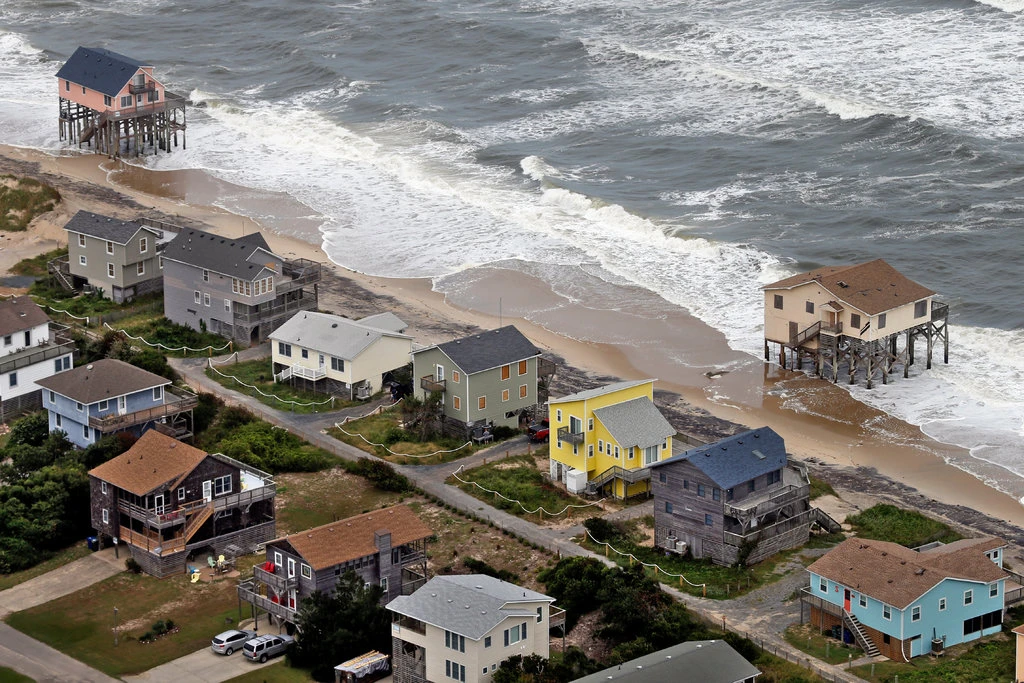 More states deciding home buyers should know about flood risks
More states deciding home buyers should know about flood risks
‘It’s a recognition that flooding is only going to get worse and that they need to take action now to protect home buyers and renters,’ says one advocate
Hours into a marathon meeting earlier this month, and with little fanfare, the North Carolina Real Estate Commission gave its blessing to a proposal that could have profound impacts in a state where thousands of homes face threats from rising seas, unprecedented rainfall and overflowing rivers. Soon, anyone who sells a home in the state will be required to disclose to prospective buyers far more about a property’s flood risks — and flood history. Rather than merely noting whether a home is in a federally designated flood zone, they will have to share whether a property has flood insurance, whether any past flood-related claims have been filed, or if the owner has ever received any federal assistance in the wake of a hurricane, tidal inundation or other flood-related disaster. With the changes, North Carolina became the fourth state this year to embrace more stringent disclosure requirements, joining South Carolina, New York and New Jersey. Advocates say the shifts, which for the most part encountered little outward opposition, represent an acknowledgment that flood risks are surging throughout the country and that more transparency about those risks is a common-sense measure that could mean more homes have flood insurance and fewer buyers face catastrophic surprises. “It’s a recognition that flooding is only going to get worse and that they need to take action now to protect home buyers and renters,” said Joel Scata, a senior attorney at the Natural Resources Defense Council, which tracks flood disclosure laws around the country. “It’s also a recognition of the importance of transparency and fairness.” The changing disclosure policies come at a time when scientists say the nation’s coastlines will experience as much sea level rise in the coming few decades as they have over the past century. They also have documented how the warming atmosphere is creating more powerful storms and more torrential and damaging rainfalls, which already are inundating communities where aging infrastructure was built for a different era and a different climate. The more stringent rules adopted this year also follow a path set by some of the country’s most flood-battered states. Louisiana, facing massive land loss from rising seas and the prospect of stronger storms, has what environmental advocates and even the Federal Emergency Management Administration agree is one of the most robust sets of disclosure laws in the nation. Likewise, in the wake of cataclysmic flooding caused by Hurricane Harvey in 2017, Texas adopted new rules that have also made the state a model for flood disclosure. But even as several additional states finalized new disclosure rules in 2023, many others still do not require sellers to divulge to buyers whether a home has previously flooded. That includes places such as Florida, which faces significant and rising risks from hurricanes, climate-fueled rain bombs and inland flooding along rivers. According to NRDC, more than one-third of states have no statutory or regulatory requirement that a seller must disclose a property’s flood risks or past flood damage to potential buyers. Others have varying degrees of requirements — a patchwork that means where people live can greatly influence how much they actually know about the flood risks of a home they buy or rent. “There are still too many states who keep home buyers in the dark,” Scata said. “That needs to change. Flooding is only going to become more severe due to climate change. And people have a right to know whether their dream home could become a nightmare due to flooding.” Earlier this year, FEMA proposed federal legislation that would require states to mandate certain minimum flood risk reporting requirements as a condition for ongoing participation in the National Flood Insurance Program. The agency said having a nationwide requirement would “increase clarity and provide uniformity” in many real estate transactions, but it has not yet become a reality. That lack of action on Capitol Hill has not stopped individual states from moving forward. In June, the South Carolina Real Estate Commission added new questions to the state’s residential disclosure that go into far more detail than before, including whether a homeowner has filed public or private flood insurance claims or made flood-related repairs that weren’t submitted to an insurer. “It’s definitely a step in the right direction,” said Nick Kremydas, chief executive of South Carolina Realtors, which publicly supported the enhanced disclosure requirements. Still, he said he hopes Congress will eventually allow buyers to access FEMA’s database of flood claims for individual properties. “That’s the best-case scenario.” Over the summer, New Jersey’s legislature overhauled what NRDC had labeled the state’s “dismal” disclosure requirements, instead putting in place new rules that require sellers to document a wide range of flood-related information. In addition, it requires that purchasers in coastal areas be warned about the potential impacts of sea level rise. “The idea is that the more people understand about the hazards, the more they can incorporate that into their decision-making, and the more they can have ownership of those decisions,” said Peter Kasabach, executive director of New Jersey Future, a nonprofit that advocates smarter growth and resilience policies. In September, New York Gov. Kathy Hochul (D) signed similar legislation, calling it a “monumental step” toward protecting residents from the increasing impacts of climate change. In addition to mandating more detailed flood information, it eliminated a previous option that allowed sellers to provide a $500 credit at closing in exchange for waiving the disclosure requirement. The legislation followed a similar measure from late 2022, requiring flood disclosures for renters. “This is a person’s home, and they should be warned,” said New York State Assembly member Robert Carroll (D), a prime sponsor of the disclosure bills. “This is really about knowledge and proper warning.” In large swaths of the country, there is little doubt that more properties are likely to face flooding risks over time. A report last year by the National Oceanic and Atmospheric Administration, NASA and other federal agencies projected that U.S. coastlines will face an additional foot of rising seas by 2050. NOAA has detailed how specific places are likely to see a sharp rise in high-tide, or nuisance, flooding, and that coastal flood warnings “will become much more commonplace” in coming decades. Likewise, scientists have documented an abnormal and dramatic surge in sea levels along the U.S. gulf and southeastern coastlines since about 2010, and other researchers have warned that the nation’s real estate market has yet to fully account for the expanding threats posed by rising seas, stronger storms and torrential downpours. In a study last year commissioned by NRDC, the independent actuarial consulting firm Milliman found that in New Jersey, New York and North Carolina, 28,826 homes sold in 2021 — 6.6 percent of total sales — were estimated to have been previously flooded. In addition, the firm found that expected future annual losses for a home with previous flood damage are significantly higher in each state than for the average of all homes, regardless of flood damage, in that state. Because one of the best indicators of whether a house will flood is whether it has flooded before, meaningful disclosure requirements are crucial, said Brooks Rainey Pearson, legislative counsel for the North Carolina branch of the Southern Environmental Law Center, which last year petitioned the state’s real estate commission on behalf of multiple environmental and community groups to make the disclosure changes. “People can take steps to protect themselves when you give them the information they need,” she said. “It matters, because with climate change we are seeing more frequent flooding events, including more intense storms and more flooding of houses. It’s a huge investment for a family to make to buy a house. People deserve to know whether the house they are purchasing has flooded or could flood.” Pearson says she hopes the changes coming to North Carolina and other states will help illuminate otherwise unknown risks and ultimately help reduce the number of homeowners who are displaced and devastated financially after storms such as Hurricane Florence, which battered her state in 2018. “What it comes down to,” she said, “is giving the buyer the information they need to make smart decisions.”
Read more » click here

GenX
For more information » click here
NC ‘Forever Chemical’ Plant Violates Human Rights, U.N. Panel Says
The allegations of human rights violations linked to pollution from the factory broadens a yearslong battle over the site and over the chemicals known as PFAS.
The dumping of contaminated wastewater by a chemical plant on the Cape Fear River began more than four decades ago, making the river water unsafe to drink for 100 miles. This week, in response to a petition by community groups in North Carolina, a United Nations panel called the pollution a human rights issue. The U.N. concerns about human-rights violations, the kind of claims that Americans might be more used to seeing leveled at foreign countries, broaden the scope of a global fight over the harms from what are known as forever chemicals, or by their acronym PFAS. They are the subject of a yearslong dispute over their dangers. Chemours, the chemicals giant that took over the plant in 2015, and DuPont before it, “are completely disregarding the rights and well-being of residents” along the river, a panel of U.N. human rights experts said. The pollution continues “even as DuPont and Chemours had information about the toxic impacts of PFAS on human health and drinking water,” they said, using the acronym for polyfluoroalkyl substances, a group of chemicals, many of which are toxic. Chemours said it was “committed to responsibly manufacturing and producing products in a manner consistent with international principles.” The products it makes at its plant at Fayetteville, N.C., contributed to “vital technologies for green hydrogen, electric vehicles and semiconductor manufacturing,” the company said. Chemours is currently moving ahead with plans to expand the Fayetteville plant. DuPont has rejected claims that it bears responsibility for the Fayetteville plant, which it spun off as part of a corporate restructuring in 2015. PFAS are human-made chemicals that companies have used to make a wide range of water- or grease-resistant products including nonstick cookware, pizza boxes, water-repellent clothing, stain-resistant fabrics and carpets, firefighting foam and some cosmetics. They don’t naturally break down and instead accumulate in the environment and in the blood and organs of people and animals. Research by both chemical companies and academics have shown that exposure to PFAS has been linked to cancer, liver damage, birth defects and other health problems. A newer type of PFAS, GenX, which Chemours makes at its Fayetteville plant, was designed to be a safer alternative to earlier generations of the chemicals. New studies, however, are discovering similar health hazards. State regulators have repeatedly fined the Fayetteville plant for exceeding emissions limits, and, over the years, the Environmental Protection Agency has also issued a string of violations. In 2021, the agency started requiring chemical manufacturers to test and publicly report the amount of PFAS in household items as part of what it calls its PFAS Strategic Roadmap, a strategy to protect public health and the environment. Still, the U.N. panel, made up of special rapporteurs from its Human Rights Council, said both the E.P.A. and local regulators had “fallen short in their duty to protect against business-related human rights abuses.” That included failing to provide affected communities in North Carolina “with the type and amount of information necessary to prevent harm and seek reparation,” the panel said. The E.P.A. declined to comment. The North Carolina Department of Environmental Quality did not immediately respond to a request for comment. Local environmentalists called on Chemours to halt its expansion in Fayetteville and focus on cleaning up the pollution. “We still have residents in our region who do not have access to clean, safe drinking water,” said Emily Donovan, co-founder of Clean Cape Fear, which petitioned last year for the United Nations to open a human rights investigation. “We’re finding PFAS along our beaches, in locally grown produce and locally caught fish. It’s also in our air and rainwater,” she said. Yet “Chemours wants to expand production and make more PFAS.”
Read more » click here

Homeowners Insurance
For more information » click here
NC has rejected the proposal to raise coastal insurance rates by 99%.
Now what happens?
State Insurance Commissioner Mike Causey called the proposed increase “excessive and unfairly discriminatory.” Insurance industry says climate change, inflation driving the need to raise premiums
In a move that surprised no one, N.C. Insurance Commissioner Mike Causey this month rejected a proposal by the state’s insurance industry to raise homeowner insurance premiums by 42% statewide and an eyewatering 99% in beach and coastal areas around Wilmington. “Homeowners were shocked with the high amount requested by the insurance companies, and so was I,” Causey said in a release. The rejection, however, doesn’t mean the end of the process, but just the beginning of likely negotiations between regulators and the industry that could be influenced by the upcoming November election, in which Causey is seeking re-election.
How did we get here?
The N.C. Rate Bureau, which represents the state’s insurance companies, cited two main factors for the surprisingly large rate increase proposal. First, is the rising cost of pretty much everything, including labor and potential repairs, driven by inflation and the lingering impacts of labor and material shortages tied to the COVID-19 pandemic. The other is climate change, which is causing more frequent and widespread property destruction, particularly tied to bigger and stronger hurricanes, as the warming climate fuels more severe weather events. Damages in North Carolina tied to 2018’s Hurricane Florence, for example, were estimated to top $22 billion, with much of that hitting inland areas. Two other factors also could be playing a role in the industry’s request, said Don Hornstein, an administrative and insurance law expert with the University of North Carolina School of Law. The first is the moratorium that was put into place during the pandemic on any rate increases. That left the industry going several years without seeing an increase in homeowner insurance rates even as the price of everything else increased. The last increase came in 2020, when insurance companies originally wanted to hike premiums by 24.5% but eventually agreed to settle for 7.9% after Causey rejected their initial request. But Hornstein said an equally big factor weighing on the size of the proposed rate increase is the cost of reinsurance − basically insurance for the insurance companies themselves in case a large-scale disaster stretches their financial ability to respond. “These increased weather risks are international, not just in the U.S.,” he said, noting the recent massive wildfires in Europe and Australia as just two examples. “And as the risk is increasing everywhere, it works to the detriment of insurers seeking reinsurance everywhere.”
Rate increase shock
The rate bureau’s recent proposal included an increase of 99.4% for beachfront properties in New Hanover, Brunswick and Pender counties in the Wilmington area and Carteret County, which includes Emerald Isle. Farther up the coast, beach areas along the Outer Banks would have seen a 45% increase. Areas on the mainland but near the Intracoastal Waterway in the Wilmington area would have seen proposed increases of 71.4% for those roughly from U.S. 17 oceanward and 43% for those farther inland. The increases would be determined by a property’s ZIP code. Proposed increases in the rest of the state also would be substantial, but not as much as a gut punch for coastal homeowners in Southeastern North Carolina. The reaction from the public and local officials was not surprising. “The Department of Insurance has received more than 24,000 emailed comments on this proposal, with hundreds more policyholders commenting by mail,” Causey said. “Scores more consumers spoke during a public comment forum. North Carolina consumers deserve a more thorough review of this proposal. “I intend to make sure they get that review.”
What happens now?
As part of the process of raising rates in North Carolina’s regulated homeowner and auto insurance markets, the insurance commissioner has the right to reject the rate bureau’s proposal and schedule a hearing. Causey has done that, scheduling a hearing for Oct. 7. State law gives the insurance commissioner 45 days to issue an order once a hearing concludes, and the insurance industry always has the option of taking the issue to the courts if they reject the commissioner’s findings. But this is an election year, and Causey, a Republican, is seeking re-election. Assuming he wins the upcoming GOP primary against two other candidates, that could make his appearances during the hearing − where he would likely attack the proposed rate increase as “excessive and unfairly discriminatory” as he already has − a strong bully pulpit for him during the height of campaign season. Many times, though, state regulators and industry negotiate a settlement behind closed doors before a hearing. Hornstein said it’s likely the parties will talk, if they aren’t already doing so, and exchange numbers and thoughts on what kind of increase would be needed to keep the state’s insurance market competitive, profitable for companies, and attractive to new entrants. He said state regulators will have to walk a fine line in balancing the desires of property owners with the needs of industry. Otherwise, Hornstein warned, North Carolina’s insurance market could end up looking like Florida, Louisiana or even more recently California, where numerous insurance companies have decided their exposures to disasters − whether hurricanes, flooding or wildfire − just isn’t worth the risk and the high premiums, costing them business, they’d need to charge consumers. “If insurers don’t feel they have enough rates, they will cancel policies or pull out,” Hornstein said, noting that Nationwide declined to renew more than 10,500 policies in the state last year, mostly due to hurricane concerns. “Either they get what they think they need, or they’ll vote with their feet.”
Read more » click here
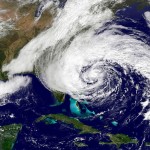
Hurricane Season
For more information » click here
Why a hot Atlantic has hurricane forecasters very worried
Hurricane season is still more than three months away, but in parts of the tropical Atlantic, it feels like we might as well already be in the thick of it. Across a strip of ocean where many cyclones are born, February ocean temperatures are closer to what scientists expect in July. The ominous warmth is stirring concerns of yet another hyperactive Atlantic hurricane season. Seven of the last eight seasons have been above normal. Last year, similarly unusual warmth fueled a storm season that was significantly more active than meteorologists might have expected given the presence of the El Niño climate pattern, which emerged last spring and creates conditions that tend to inhibit Atlantic cyclone formation. As meteorologists look ahead to this hurricane season, which begins June 1, they see an increasing likelihood that a La Niña pattern will replace El Niño by late summer or early fall. That is another bad sign for the U.S. coastline — La Niña is associated with active patterns in the tropical Atlantic. It’s still too early to say whether the warmth will persist into hurricane season, or when La Niña might arrive. But, especially together, the trends suggest that an active season could be difficult to avoid, said Michael Lowry, a meteorologist with WPLG-TV in Miami and a former National Hurricane Center scientist. “There’s plenty of time ahead before we get to the meatiest part of the hurricane season,” Lowry said. “But a lot’s going to have to change … for forecasters to feel much more comfortable going into hurricane season.”
A persistent trend of record warmth
Last spring, the strongest climate signal scientists know of — El Niño — gave every indication of a slowdown in Atlantic hurricane activity in the summer and fall. El Niño’s signature is a surge of warm waters and towering clouds in the central and eastern Pacific. It triggers changes in atmospheric circulation that, on the other side of the planet, can make it harder for tropical storms to form and strengthen: Areas of high pressure with sinking air are more common over the Atlantic, and wind shear, when wind speed and direction vary at different altitudes, increases. The expectation of El Niño prompted National Oceanic and Atmospheric Administration forecasters to predict a mostly typical Atlantic hurricane season, a downgrade from years of increased storm activity. But as El Niño developed, and unusual warmth appeared well beyond the Pacific zones the climate pattern is known for, forecasters warned that a quieter season was far less than certain. By August, it became clearer: The ocean warmth was likely to counteract El Niño’s typical effect in the Atlantic, and NOAA upgraded its forecast. The season ended up with about 20 percent more activity than average, as measured by a statistic known as accumulated cyclone energy. Now, with a new tropical weather season ahead, Atlantic temperatures are perhaps even more remarkable.
Why meteorologists have reason for concern
In a zone of the Atlantic known as the main development region for hurricanes, sea surface temperatures are running well above normal — and 1.1 degree Fahrenheit (0.6 degrees Celsius) higher than in any other year on record, said Philip Klotzbach, a tropical meteorologist at Colorado State University. If that trend persists into hurricane season this summer, it could mean a ripe environment for tropical waves flowing from Africa to develop into cyclones. “Basically, it is the perfect recipe for hurricanes to form and strengthen,” Alejandro Jaramillo, a meteorologist at the National Autonomous University of Mexico, said in an email. “The warmer waters provide extra fuel available for hurricanes, potentially leading to the formation of stronger storms.” One factor behind the Atlantic warmth: weak winds over the ocean, Klotzbach said. That discourages evaporation, which would allow the waters to cool by transferring heat into the air. Models suggest weaker-than-normal winds continuing into March, Klotzbach said. Beyond that, longer-term models predict that surface temperatures will remain elevated, and that by the heart of hurricane season, from August through October, precipitation will be above normal across the tropical Atlantic, something that suggests a strong pattern of waves flowing off Africa, Klotzbach said. If those predictions come to pass, “I’d expect a very busy season in store,” he said in an email. Meanwhile, climate scientists predict that La Niña is more likely than not to develop by August. While El Niño increases wind shear — which acts to disrupt hurricanes’ columns of rotating winds — La Niña tends to discourage it, clearing the way for storms to organize and strengthen. The warm water in the tropical Atlantic is part of a global pattern of record sea-surface temperatures, fueled by both El Niño and human-caused climate change. The planet’s average sea surface temperature reached an all-time record of 70.2 degrees Fahrenheit (21.2 Celsius) on Feb. 9, according to the University of Maine’s Climate Change Institute.
Why it’s too soon to panic
Meteorologists stressed that it is far too soon to say how the hurricane season may play out. Official seasonal forecasts from NOAA, Colorado State and other sources won’t arrive for months, and even they carry plenty of uncertainty. And there is still much scientists don’t understand about how the ocean behaves and what triggers longer-term changes in tropical weather. For example, it wasn’t immediately clear what was behind an unusual drought of Atlantic hurricanes in the 1970s and 1980s — until scientists realized that a surge in air pollution from Europe was acting to cool the tropical Atlantic by blocking sunlight, said Kerry Emanuel, a professor at the Massachusetts Institute of Technology. Similarly, it isn’t yet clear why the Atlantic is warming more dramatically than other oceans, or for how long it will continue, he said. Even if scientists could predict an active hurricane season with more certainty, “that’s not what you want,” Emanuel said. “You want the number of destructive landfalling storms.” That is outside meteorologists’ capabilities — it was just last year that NOAA extended its tropical outlooks to seven days. But Lowry said the state of the Atlantic is such that, even if ocean temperatures trend closer to normal, there is still far more heat in the waters that could be available for storms come summer and fall. “This is such an extreme case that it doesn’t bode well,” he said.
Read more » click here
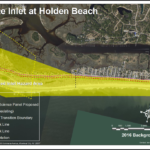
Inlet Hazard Areas
For more information » click here
CRC science panel to resume Inlet Hazard Areas discussion
The science panel that advises the state’s Coastal Resources Commission has scheduled a virtual meeting to pick up its review of Inlet Hazard Areas boundaries that began during its Nov. 27, 2023, meeting and discuss recent studies and data on sea level rise. The meeting is to begin at 2 p.m. Thursday, Feb. 29, and is open for public listening either online or call 415-655-0003 and use access code 242 570 64312. Comments can be submitted to [email protected] with “Science Panel” in the subject line. The Coastal Resources Commission, known as the CRC, sets rules and policies for the 20 coastal counties, which the Division of Coastal Management, under the North Carolina Department of Environmental Quality, carries out. The science panel provides the CRC with scientific data and recommendations pertaining to coastal topics. Inlet Hazard Areas are areas of environmental concern that are especially vulnerable to erosion, flooding, and other adverse effects of sand, wind, and water because of their proximity to dynamic ocean inlets, according to the “Inlet Hazard Area Boundary, 2019 Update: Science Panel Recommendations to the North Carolina Coastal Resources Commission.” The panel during its November meeting began the discussion on Inlet Hazard Areas because of the three-part charge issued by the CRC to reevaluate every five years its IHA methods and boundaries, incorporating data collected since its 2019 study, reassess its 2019 recommendations and consider alternative methods for calculating oceanfront shoreline change rates. They are to present the draft reports including proposed ag boundaries and erosion rates in summer of 2024. The panel discussed the background of IHAs, the work that has taken place since the ongoing effort began in the late 2000s, complications, and possible alternatives, such as using different approaches for the inlets experiencing the most erosion. They will continue this discussion.
Read more » click here
.
Lockwood Folly Inlet
For more information » click here.

Seismic Testing / Offshore Drilling
For more information » click here.

Offshore Wind Farms
For more information » click here
Thanks to Duke Energy,
offshore wind is blowing back into NC’s clean energy picture
There are currently three areas leased for offshore wind farms along the N.C. coast, including two about 20 miles south of Brunswick County. The project furthest along is off the Outer Banks
From concerns about financing to potential impacts on the highly endangered North Atlantic right whale, developers of offshore wind projects had to navigate some rough waters in 2023. That stormy weather included efforts by companies to renegotiate their contracts with utilities due to rising construction costs, higher inflation and supply chain disruptions, and the war in Ukraine. Those headwinds culminated in some developers deciding to walk away from projects rather than get stuck in money-losing endeavors. But the winds now seem to be blowing in the renewable energy sector’s favor, including for a pair of wind farms planned for the waters just south of Brunswick County. Late last year, a 132 megawatt (MW) project off New York’s Long Island became the first offshore wind farm in the country to start sending power onshore. Parts of another wind farm off Massachusetts came online in early January. Then in late January Duke Energy, citing a projected massive increase in future demand on its power grid, announced it was moving forward with plans to add 2.4 gigawatts (GW) of offshore wind to its grid in the 2030s as part of its updated carbon plan. The plan maps out proposed roadmaps for the utility giant to meet North Carolina’s future power needs while also reducing carbon emissions from the state’s energy sector, with a goal of reaching net-zero emissions by 2050. Duke’s commercial renewables arm and Total Energy Renewables in 2022 secured neighboring leases from the U.S. Bureau of EM to build offshore wind farms in the open ocean about 18 miles south of Bald Head Island. Duke has said its 54,000-acre site, which it paid the federal government $155 million to lease, could support 1.6 gigawatts of wind power. While the two companies teamed up for some survey work in the proposed project areas last summer, it will still be years before any giant wind turbines start rising from the Brunswick waters. Still, the steps from getting U.S.-based wind farms generating power to Duke’s decision to add offshore wind to its future power grid needs are all important moves in the right direction, said Katharine Kollins, president of the Southeastern Wind Coalition. “Offshore winds needs to be a key component if we’re going to meet the decarbonizing requirements outlined in House Bill 951,” she said, referring to the 2021 legislation that enshrined the state’s emission-reducing carbon plan into law. “You cannot do that without offshore wind.” In its updated carbon plan filing with the N.C. Utilities Commission, Duke notes that a lot of financial uncertainties still surround offshore wind − especially when trying to project capital development and operating costs a decade or more out for these complicated, capital-intensive projects. But Kollins said a lot of the information that any new study would require could be gleamed from the increasing number of wind farms that are coming online in the coming years, including the Kitty Hawk Wind energy area that’s been under development off the Outer Banks since 2017. She added that some information that a wind farm developer would require to move forward, such as status of the sea floor around a proposed project along with wind and weather data, also could start being gathered now instead of later, allowing projects to move into the development phase that much faster. Preliminary work on securing infrastructure that can take long lead-in times, like undersea cables and substations, also could be initiated with developers as well as starting the conversation on permitting and rates rather than waiting. “It’s time and certainty, and that’s what these projects need right now,” Kollins said. “They need to know that North Carolina is a market, a reliable market for wind energy.”
Read more » click here
Things I Think I Think –
 Eating out is one of the great little joys of life.
Eating out is one of the great little joys of life.
Restaurant Review:
The Dinner Club visits a new restaurant once a month. Ratings reflect the reviewer’s reaction to food, ambience and service, with price taken into consideration.
///// December 2023
Name: Villa Romana
Cuisine: Italian
Location: 707 South Kings Highway, Myrtle Beach SC
Contact: 843.448.4990 / https://www.villaromanamyrtlebeach.com/
Food: Average / Very Good / Excellent / Exceptional
Service: Efficient / Proficient / Professional / Expert
Ambience: Drab / Plain / Distinct / Elegant
Cost: $23 Inexpensive <=20 / Moderate <=26 / Expensive <=35 / Exorbitant <=60
Rating: Three Stars
A quintessential Italian restaurant, it feels like the great Italian restaurants that were more prevalent many years ago. Apparently, they have renovated since our last visit the traditional Roman architecture with its columns, statues, and fountains have been removed. Frankly, although it was a bit kitschy I miss them. The roving accordion player contributes to its old-world charm. Established in 1985, the menu reflects home-style interpretations of their family recipes that have been handed down from generation to generation. What makes them great is they are happy to prepare any dishes you want as long as the ingredients are available. It’s an exceptional value, the food is wonderful, the portions are generous, and the prices are reasonable. What’s not to like?
Dining Guide – Local * Lou’s Views (lousviews.com)
Dining Guide – North * Lou’s Views (lousviews.com)
Dining Guide – South * Lou’s Views (lousviews.com)
Restaurant Reviews – North * Lou’s Views (lousviews.com)
Restaurant Reviews – South * Lou’s Views (lousviews.com)
Book Review:
Read several books from The New York Times best sellers fiction list monthly
Selection represents this month’s pick of the litter
 The Spy Coast by Tess Gerritsen
The Spy Coast by Tess Gerritsen
When a recent visitor’s body turns up tortured and dead in her driveway, former CIA agent Maggie Bird secret past catches up with her. Maggie connects the dots to her last case that forced her into retirement after a mission that went tragically wrong, She turns to her friends, members of The Martini Club, all former retired CIA operatives to help her uncover the truth by investigating who has come back to hunt her down. It’s very reminiscent of Richard Osman’s Thursday Murder Club series.
That’s it for this newsletter
See you next month
Lou’s Views . HBPOIN
. • Gather and disseminate information
. • Identify the issues and determine how they affect you
. • Act as a watchdog
. • Grass roots monthly newsletter since 2008

